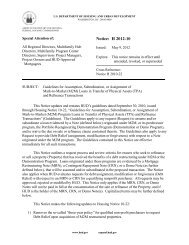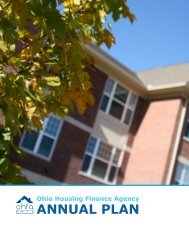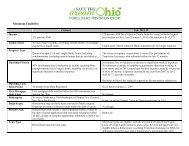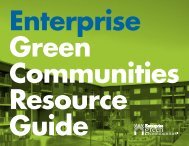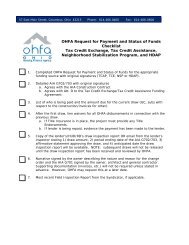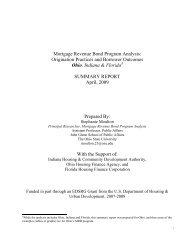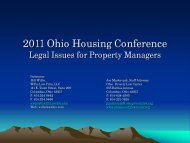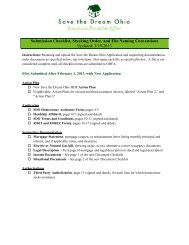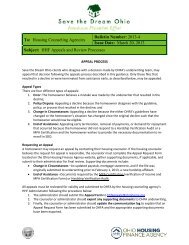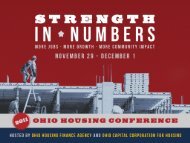lis 217 stemming the tide - LISC
lis 217 stemming the tide - LISC
lis 217 stemming the tide - LISC
- No tags were found...
You also want an ePaper? Increase the reach of your titles
YUMPU automatically turns print PDFs into web optimized ePapers that Google loves.
Intermediary TechnicalAssistance Grant (ITAG). HUDfunds available to residentgroups, community-based nonprofitdevelopers, and publicagencies seeking to preserve orpurchase federally subsidizedhousing. Includes ResidentCapacity Grants ($20,000),Predevelopment Grants($70,000), and Public EntityGrants ($20,000). Except forPublic Entity Grants, <strong>the</strong>se arefor project-specific activities.ITAG Intermediary.Organizations responsible fordisbursing and monitoring ITAGfunds in a geographic region,under contract to HUD.Low Income HousingPreservation and ResidentHomeownership Act (LIHPRHA).1990 statute authorizing <strong>the</strong>"permanent" federal preservationprogram. Program active1990 - 1996.Like Kind Exchange. A taxdeferralmechanism involving a"swap" of <strong>the</strong> project beingsold with a replacement project.Capital gains tax is deferreduntil <strong>the</strong> replacement propertyis sold.Lite/OMHAR Lite. A transactioncarried out under <strong>the</strong> Mark-to-Market program, involving rentreduction but no debt restructuring.Lite transactions may ormay not involve refinancing of<strong>the</strong> existing debt.Loan Management Set-Aside(LMSA). A form of project-basedSection 8 assistance used primarilyfor Section 221(d)(3)/BMIR and Section 236 housing.These contracts were addedafter <strong>the</strong> housing was developedand were short-term,renewable.Multifamily Assisted HousingReform and Affordability Act(MAHRA). 1997 statute authorizing<strong>the</strong> Mark-to-Market programand renewals of expiring Section8 contracts.Mark-to-Market. A programenabling owners of above-marketSection 8 properties withHUD-insured mortgages toreduce rents, restructure <strong>the</strong>existing debt, and generallyrenew project-based Section 8subsidy contracts. Authorized byMAHRA and administered byPAEs under contract toHUD/OMHAR. Owners who participatein debt restructuringmust agree to 30-year Section 8renewals, and underlying userestrictions for a portion of <strong>the</strong>units. Tenants and state/localgovernments have an opportunityto participate in <strong>the</strong> restructuringplans.Mark-Up-to-Market. A programenabling eligible owners ofbelow-market Section 8 properties(insured and uninsured) torenew expiring subsidy contractsat comparable marketrents. Contracts must be at least5 years.Mortgage Insurance Fund. TheHUD reserves that are drawnupon in <strong>the</strong> event of mortgageforeclosure or assignment, topay off <strong>the</strong> lender in response toan insurance claim.Operating Cost AdjustmentFactor (OCAF). Percentage factorused to adjust Section 8 projectbasedrents. Pub<strong>lis</strong>hed by HUDon an annual basis. The OCAFpercentage is applied to <strong>the</strong>Section 8 gross rents less debtservice, i.e. to operating expensesplus cash flow.New Construction/SubstantialRehab. A form of project-basedSection 8 assistance used in <strong>the</strong>original development andfinancing of <strong>the</strong> housing.Projects are both insured anduninsured (with conventional orstate/local bond financing).These contracts are long-term(20-40 years). Active 1976 -1985.OMHAR. Office of MultifamilyHousing AssistanceRestructuring, a special officewithin HUD estab<strong>lis</strong>hed underMAHRA to oversee <strong>the</strong> Mark-to-Market Program. OMHAR hasrecently been brought under <strong>the</strong>authority of <strong>the</strong> FHACommissioner/ AssistantSecretary for Housing.Outreach and Training Grant(OTAG). HUD funds available toorganizations working with residentsand resident groups infederally-subsidized housing.Participating AdministrativeEntity (PAE). The ParticipatingAdministrative Entity is responsiblefor structuring Mark-to-Market transactions at <strong>the</strong> localor state level, under contract toOMHAR. PAEs may be public orprivate entities or joint ventures.Passive Losses. Losses ordeductions generated by a propertywhich exceed <strong>the</strong> amountneeded to offset taxable income.Since <strong>the</strong> Tax Reform Act of 1986,passive losses can no longer beused to shelter ordinary incomefrom taxation; however, <strong>the</strong>y canbe used to offset "phantomincome" or capital gains tax liabilitywhen <strong>the</strong> property is sold.Phantom Income. Income taxableto a property owner in anAffordable Housing Preservation Glossary63



